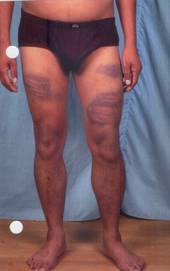The case
In September 2010, TRIAL submitted an individual complaint to the United Nations Human Rights Committee against Bosnia-Herzegovina (BiH) concerning the enforced disappearance of Mensud Rizvanović, which occurred in July 1992. In this case, ACT is acting on behalf of Mrs Fatima Rizvanović and Mrs. Ruvejda Rizvanović, who are respectively the mother and the wife of Mr. Mensud Rizvanović.
On 20 July 1992 Mr. Mensud Rizvanović was arbitrarily deprived of his liberty in Rizvanovići (BiH) by members of the army of the Republika Srpska (Vojska Republike Srpske – VRS) taking part in ethnic cleansing operationsperpetrated in that area. He was afterwards taken to the detention camp Keraterm, where he was subjected to ill treatment and inhumane conditions. He was seen alive for the last time by eyewitnesses in the hands of the guards of the facility in life threatening circumstances. The fate and whereabouts of Mr. Mensud Rizvanović remain unknown since then.
In spite of numerous attempts from his relatives to establish the truth regarding the circumstances of the arbitrary deprivation of liberty and the subsequent enforced disappearance of Mr. Mensud Rizvanović, his fate and whereabouts and the progress and results of the investigations remain unknown. Since then, Mrs. Fatima Rizvanović and Mrs. Ruvejda Rizvanović have lived in a lacerating situation of uncertainty.
Indeed, 18 years after the events, no ex officio, prompt, impartial, thorough and independent investigation has been carried out by BiH authorities and no one has been prosecuted, judged and sanctioned for the arbitrary deprivation of liberty, the ill-treatment and the enforced disappearance of Mr. Mensud Rizvanović, thus fostering an ongoing climate of impunity. Although both the authors have provided their DNA samples to international mechanisms and national institutions dealing with the subject of missing persons, to date the mortal remains of Mr. Mensud Rizvanović have not been duly located, exhumed, identified and returned to the family.
To date, Mrs. Fatima Rizvanović and Mrs. Ruvejda Rizvanović have not received reparation or compensation for the harm suffered by them and their loved one.
TRIAL therefore submitted an individual communication to the United Nation Human Rights Committee asking it :
to recognise that BiH violated numerous articles of the International Covenant on Civil and Political Rights subsequently to Mr. Rizvanović’s enforced disappearance, even though BiH has ratified the Covenant;
to declare that BiH also violated the Covenant with regard to the suffering caused byRizvanović‘s mother and spouse owing to his disappearance;
to request BiH undertake all necessary action to launch independent investigations as a matter of urgency with a view to locating Mr. Mensud Rizvanović and, in the event of his death, exhuming, identifying, respecting and returning his mortal remains to the authors;
to request BiH undertake all necesary action to identify those responsible for his arbitrary deprivation of liberty, ill-treatment and subsequent enforced disappearance, judge and sanction them;
to request BiH undertake all necesary action to guarantee that Mrs. Fatima Rizvanović and Mrs. Ruvejda Rizvanović obtain without any further delay fair and adequate compensation and, in particular, access to medical and psychological care free of charge.
The General Context
It is estimated that between 100,000 and 200,000 persons died as a consequence of the conflict (1992-1995) in BiH and that between 25,000 and 30,000 were victims of enforced disappearance.
The disappearance of Mr. Mensud Rizvanović took place within the general context of the “ethnic cleansing” operations that occurred in July 1992. To date, no one has been convicted, prosecuted and punished for his enforced disappearance, thus fostering an overall climate of impunity.
In 2010 the International Commission on Missing Persons (ICMP) and the International Committee of the Red Cross estimated that around 10,000 people remain disappeared in BiH.
The decision
In March 2014, the UN Human Rights Committee released its decision for the case of Mensud Rizvanović.
According to the Committee, Bosnia and Herzegovina violated several articles of theInternational Covenant on Civil and Political Rights. In particular rights to:
- life
- prohibition of torture
- personal liberty
In addition, the fact that the authors of the complaint were forced to declare their disappeared family member dead in order to receive compensation is another violation of the Covenant.
The Committee requested Bosnia and Herzegovina to:
establish the fate and whereabouts of Mensud Rizvanović
bring to justice those responsible for his enforced disappearance by the end of 2015
ensure adequate compensation
ensure that investigations into allegations of enforced disappearances are accessible to missing persons’ families
amend the legal framework so that relatives do not have to obtain a declaration of death to their due social benefits
The author of the complaint, Fatima Rizvanović, a relative of Mensud Rizvanović sadly passed away before the adoption of the Human Rights Committee’s decision.
Bosnia and Herzegovina has now 180 days to inform the Committee about the measures taken to implement the decision.

 Mr. Sherpa was a porter and cook during trekking expeditions in the Nepalese mountains. On 18 July 2007 as he was walking back home, Mr. Sherpa was assaulted by a group of police officers who arrested him without producing a warrant or informing him of the grounds for his arrest. Mr. Sherpa was then beaten and dragged by his arms and hair to the Jorpati Police Bit where he was again severely beaten by the police officers with a bamboo stick until he fell unconscious. Mr. Sherpa was neither informed of his rights nor given the opportunity to contact his family, legal counsellor or friends. Subsequently, Mr. Sherpa was transferred in a state of semi-consciousness to the Metropolitan Police Circle Boudha where he was kept in inhuman conditions of detention. Namely, he was placed in an overcrowded room, endowed with no mattresses and no toilet facilities. Neither food nor water was provided to him. Despite a report by the visiting doctor clearly pointing out the need for Mr. Sherpa to receive medical attention for the grave injuries he presented as a result of the beatings he had suffered, he was not afforded any medical care. Mr. Sherpa was finally released the following day, 19 July 2007 at 18h00. He was never accused or charged of anything. Upon release Mr. Sherpa was threatened not to seek redress before the justice system as otherwise he would be “punished”.
Mr. Sherpa was a porter and cook during trekking expeditions in the Nepalese mountains. On 18 July 2007 as he was walking back home, Mr. Sherpa was assaulted by a group of police officers who arrested him without producing a warrant or informing him of the grounds for his arrest. Mr. Sherpa was then beaten and dragged by his arms and hair to the Jorpati Police Bit where he was again severely beaten by the police officers with a bamboo stick until he fell unconscious. Mr. Sherpa was neither informed of his rights nor given the opportunity to contact his family, legal counsellor or friends. Subsequently, Mr. Sherpa was transferred in a state of semi-consciousness to the Metropolitan Police Circle Boudha where he was kept in inhuman conditions of detention. Namely, he was placed in an overcrowded room, endowed with no mattresses and no toilet facilities. Neither food nor water was provided to him. Despite a report by the visiting doctor clearly pointing out the need for Mr. Sherpa to receive medical attention for the grave injuries he presented as a result of the beatings he had suffered, he was not afforded any medical care. Mr. Sherpa was finally released the following day, 19 July 2007 at 18h00. He was never accused or charged of anything. Upon release Mr. Sherpa was threatened not to seek redress before the justice system as otherwise he would be “punished”.